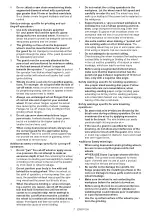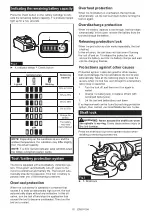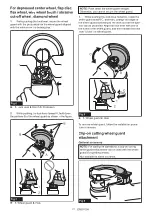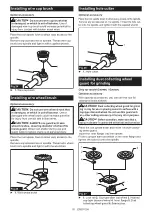
8
ENGLISH
7.
Do not leave the tool running. Operate the tool
only when hand-held.
8.
Do not touch the workpiece immediately after
operation; it may be extremely hot and could
burn your skin.
9.
Do not touch accessories immediately after
operation; it may be extremely hot and could
burn your skin.
10.
Observe the instructions of the manufacturer
for correct mounting and use of wheels and
accessories.
Incorrect mounting and use may
result in personal injury.
11.
Handle and store wheels with care.
12.
Do not use separate reducing bushings or
adaptors to adapt large hole abrasive wheels.
13.
Use only flanges specified for this tool.
14.
For tools intended to be fitted with threaded
hole wheel, ensure that the thread in the wheel
is long enough to accept the spindle length.
15.
Check that the workpiece is properly
supported.
16.
Pay attention that the wheel continues to
rotate after the tool is switched off.
17.
If working place is extremely hot and humid,
or badly polluted by conductive dust, use a
short-circuit breaker (30 mA) to assure opera-
tor safety.
18.
Do not use the tool on any materials contain-
ing asbestos.
19.
When use cut-off wheel, always work with
the dust collecting wheel guard if required by
domestic regulation.
20.
Cutting discs must not be subjected to any
lateral pressure.
21.
Do not use cloth work gloves during operation.
Fibers from cloth gloves may enter the tool, which
causes tool breakage.
22.
Before operation, make sure that there is no
buried object such as electric pipe, water pipe
or gas pipe in the workpiece.
Otherwise, it may
cause an electric shock, electrical leakage or gas
leak.
23.
If a blotter is attached to the wheel, do not
remove it. The diameter of the blotter must be
larger than the lock nut, outer flange, and inner
flange.
24.
Before installing a grinding wheel, always
check that the blotter part does not have any
abnormalities such as chips or cracks.
25.
Tighten the lock nut properly.
Overtightening
the wheel can cause breakage and insufficient
tightening can cause fluttering.
SAVE THESE INSTRUCTIONS.
WARNING:
DO NOT let comfort or familiarity
with product (gained from repeated use) replace
strict adherence to safety rules for the subject
product. MISUSE or failure to follow the safety
rules stated in this instruction manual may cause
serious personal injury.
Important safety instructions for
battery cartridge
1.
Before using battery cartridge, read all instruc-
tions and cautionary markings on (1) battery
charger, (2) battery, and (3) product using
battery.
2.
Do not disassemble or tamper with the battery
cartridge.
It may result in a fire, excessive heat,
or explosion.
3.
If operating time has become excessively
shorter, stop operating immediately. It may
result in a risk of overheating, possible burns
and even an explosion.
4.
If electrolyte gets into your eyes, rinse them
out with clear water and seek medical atten-
tion right away. It may result in loss of your
eyesight.
5.
Do not short the battery cartridge:
(1)
Do not touch the terminals with any con-
ductive material.
(2)
Avoid storing battery cartridge in a con-
tainer with other metal objects such as
nails, coins, etc.
(3)
Do not expose battery cartridge to water
or rain.
A battery short can cause a large current
flow, overheating, possible burns and even a
breakdown.
6.
Do not store and use the tool and battery car-
tridge in locations where the temperature may
reach or exceed 50 °C (122 °F).
7.
Do not incinerate the battery cartridge even if
it is severely damaged or is completely worn
out. The battery cartridge can explode in a fire.
8.
Do not nail, cut, crush, throw, drop the battery
cartridge, or hit against a hard object to the
battery cartridge.
Such conduct may result in a
fire, excessive heat, or explosion.
9.
Do not use a damaged battery.
10.
The contained lithium-ion batteries are subject
to the Dangerous Goods Legislation require-
ments.
For commercial transports e.g. by third parties,
forwarding agents, special requirement on pack-
aging and labeling must be observed.
For preparation of the item being shipped, consult
-
ing an expert for hazardous material is required.
Please also observe possibly more detailed
national regulations.
Tape or mask off open contacts and pack up the
battery in such a manner that it cannot move
around in the packaging.
11.
When disposing the battery cartridge, remove
it from the tool and dispose of it in a safe
place. Follow your local regulations relating to
disposal of battery.
12.
Use the batteries only with the products
specified by Makita.
Installing the batteries to
non-compliant products may result in a fire, exces
-
sive heat, explosion, or leak of electrolyte.









































